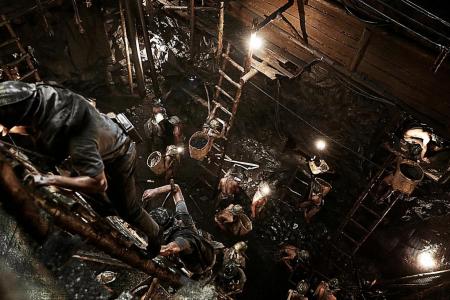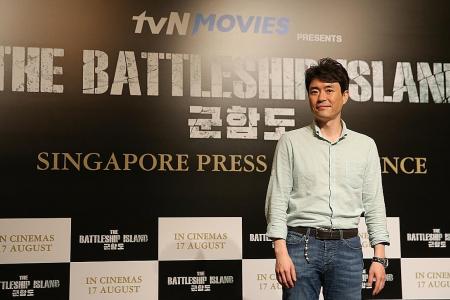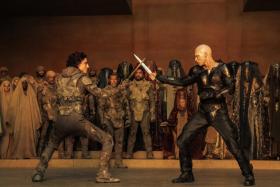The Battleship Island took 4 years to research, shoot
The Battleship Island's director confident movie depicts accurate oppression of S. Koreans
The Battleship Island is a war flick that deals with the turbulent period when South Koreans were forced into slave labour by the Japanese on Hashima Island, the site of Japan's first major undersea coal exploitation.
It is also a film that is at the centre of a heated debate.
Some claim it depicts Korean characters as overly villainous compared to the Japanese corporate executives who held them captive.
But the film's director Ryoo Seung Wan is confident that he and his crew have given their all in both the scope of the cinematography and depiction of facts.
The Battleship Island, starring Hwang Jung Min, So Ji Sub and Song Joong Ki, opens here tomorrow.
It tells the story of three men staging an escape from a labour camp with 400 fellow Korean prisoners during the Japanese colonial era.
"It took a total of four years to complete the research and shooting," Ryoo, 43, told The Korea Herald in Seoul's Samcheong-dong last Thursday.
Finding organised accounts of the event was difficult, Ryoo said.
"Novelist Han Su San's Crow is the first work of art to try and deal with the subject. It was a challenge to wade through all of the scattered records."
After the 2005 boxing drama Crying Fist, the 2006 gangster action movie The City Of Violence, and the 2010 crime drama The Unjust, Ryoo sealed his status as a hitmaker with the 2013 thriller The Berlin Files.
His 2015 satire of South Korea's chaebol culture, Veteran, sold more than 13 million tickets and became the third best-selling movie of all time there.
Surprisingly, he feels little pressure to live up to past films.
"I am the kind of person who pursues only stories that I am dying to tell, the stories that will drive me crazy if I do not tell them," Ryoo said.
"I am glad when the public can see different sides of me through my films, but I am bad at calculating my career steps or things outside of the artistic aspects."
MASSIVE SET
The Battleship Island, which had a massive set recreating Hashima Island's coal mines, is Ryoo's priciest undertaking yet, with a budget of 22 billion won (S$26.4 million). The amountallowed him to focus on what he wanted to achieve artistically.
"I figured it was an opportunity that I might never have again. It made me focus on the essence of the film. It was a huge venture for the Korean film industry as well.
"I concentrated on only what kind of situations, characters and sounds I wanted to create."
Ryoo said he had been driven by a sense of duty to raise awareness of the deeply atrocious, but less publicised, subject.
He first learnt about Hashima Island and its turbulent history in 2013.
Said Ryoo: "I felt so embarrassed. I could not believe I had not known about it until after my 40s."
The controversy over the film's historical stance baffles him because he had meant to tread carefully around sensitive historical subjects.
"The coal mine was closed down in 1974, but it is still something that is ongoing for the survivors that suffered there. We did not want to do them wrong."
Much attention was paid to the detail of the workers slaving away 1km underground in the coal mine, Ryoo said.
"Down there, the heat was so intense, people literally could not keep any piece of clothing on. We made (the actors') skin shiny due to the continuous sweat and underground water, mixed with dirt and heat."
The colonisers' tyranny is expressed in a more subtle way, Ryoo said.
"In the movie, the Japanese never directly harm or get angry at the workers," said Ryoo.
"It is the basic rule of colonisation - to create a collaborator among the oppressed and create strife among the colonised." - THE KOREA HERALD/ ASIA NEWS NETWORK
Get The New Paper on your phone with the free TNP app. Download from the Apple App Store or Google Play Store now




